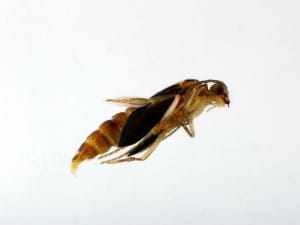At last we have normal water levels after the desperately low water of much of 2013. The increased flow has removed most of the silt that made sight fishing so difficult last year and we now have clean gravels and signs of recovery of the Ranunculus weed beds.
Cormorants had a devastating effect on the grayling numbers during the winter of 2012/13 and few grayling have been caught recently, however several grayling of over 3lb have been caught by those prepared to face blank sessions. Fortunately the trout are less prone to fall prey to the cormorants as they seek cover rather than milling about in the open as a shoal like the grayling. Some big trout have been caught overwinter by grayling anglers.
My monthly invertebrate sampling shows there to be large numbers of Gammarus (shrimps) (up to 1000 in a 3 minute kick sample) and increasing numbers of cased Caddis larvae, particularly the tiny Agapetus fuscipes (again up to 1000 per kick sample). However, Baetis nymphs and Blue-winged Olive nymphs are virtually non-existent after last year’s low water and siltation. Anglers will therefore have to take these facts into account when planning their strategies for the first few months of the new season.
There will not be the Large Dark Olives that gave good sport in the first weeks of 2013. So visitors in April will be best fishing shrimp and caddis larvae imitations (weighted Shrimps, Rhyacophila and Peeping Caddis). April dry fly activity is likely to be confined to tiny Chironomid midges, occasional adult Rhyacophila sedges (size 12 F Fly or Elk Hair Caddis) and possibly a few early Craneflies/Daddies. Hopefully by the end of April and into May we will see the return of the Hawthorn flies and Black Gnats that were virtually absent due to the floods in 2012/13 that killed their larvae which are terrestrial.
By June the Agapetus pupae should be emerging in increasing numbers. The Driffield Beck usually produces vast numbers of this micro-caddis. The mature larval cases look like 3mm diameter igloos and are impossible to imitate, but the emerging pupae can provide great sport to those ‘in the know’. The emerging pupae are 5mm long and they have a strong pair of oar-like legs with which they swim vigorously to the bank where they climb up emergent vegetation upon which the adults break out of the pupal exoskeleton. As a result, fish feeding on the pupae can feed quite aggressively but appear to be taking something invisible in the surface film. This is very different from midge-feeders taking either Midge pupae or the adult Midges that very gently sip in in their prey. A scruffy size 20 unweighted Gold-ribbed Hare’s Ear nymph tweeked thorough the surface is a good fly for fish taking Agapetus pupae (or you could tie up some Stuart Crofts’ Agapetus Pupae).
Dave Southall


Leave a Reply